By Lee Atkinson
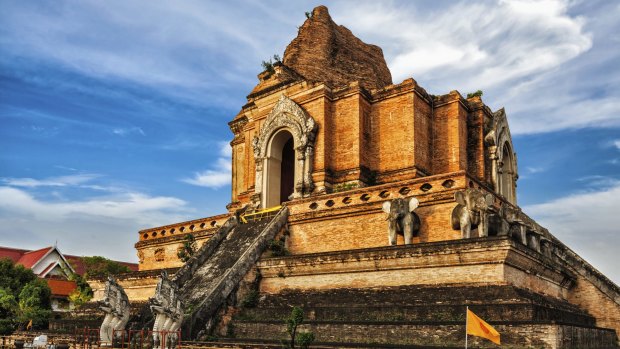
Buddhist temple Wat Chedi Luang in Chiang Mai, Thailand.Credit: iStock
It's my first day in Chiang Mai, the ancient city in northern Thailand that was once the capital of the Kingdom of Lanna and, with more than 200 Buddhist temples scattered across the city, is still the country's spiritual heart. It's only 10am and blisteringly hot, but already I've marvelled at the 15th-century Wat Chedi Luang with its towering, albeit crumbling, stupa decorated with stone elephants and the even older Wat Phra Singh with its elaborately painted prayer hall.
Now, high on a mountaintop on the outskirts of the city, laid out in glittering glory before me is Wat Phra That Doi Suthep, a golden temple surrounded by gilded buddhas, mirror-tiled stupas and jewel-encrusted serpents, all shining so brightly that it brings tears to my eyes. It is an amazing sight but all I can think about, as my earnest guide (whose ability to mangle English into something incomprehensible is masterful) rattles off an endless list of dates and kings I've never heard of, is how good a coffee would be now, or if it's too early for a cold beer, or even better, a cocktail by the pool or at the least, how nice it would be to be back in my airconditioned hotel room. There's a name for this: it's called temple fatigue, and it happens to us all.
The temples of Angkor Wat, Borobudur, Kyoto, Chiang Mai, Bagan... – the list is long – are some of the most remarkable buildings constructed and no trip to just about anywhere in Asia is complete without a visit to one (or three, or four). But it doesn't take long for them all to start to look the same, even if they are world heritage-listed wonders of the ancient world.
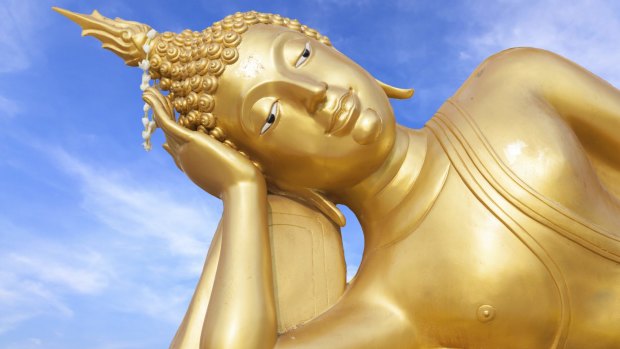
A Buddha statue in Chiang Mai. Credit: iStock
So how do you combat temple fatigue? Quality, rather than quantity, is the key, according to Sujata Raman, managing director at travel company Abercrombie & Kent. "Limit yourself to one or two cultural sites a day that you really want to see," Raman says. "Do them really well rather than try and squeeze in as many as you can."
Tara Kennaway, Intrepid Travel's product manager for Asia, believes that using a guide can make all the difference. "A good guide will help bring the stories of the temples to life and they'll mean so much more to you."
Not all guides are created equal though. Touts, tuk tuk and taxi drivers will often volunteer to show you around – in return for a generous tip – but as I discovered in Chiang Mai their English (and their knowledge) is often limited. Ask the concierge at your hotel to recommend a good guide. Alternatively, a guide book can help demystify what you are looking at. It can also help if you think of it not as a religion you know nothing about but an open air art gallery or museum.
Limit yourself to one or two cultural sites a day that you really want to see.
Sujata Raman
"If you're into photography, think about choosing one aspect of temples to focus on and build a series of photos around a theme rather than trying to capture everything," Kennaway says. "It all starts to look the same otherwise, and keeps things interesting for you. For example, focus on the incense, or the shoes left at the entrance. Look for the subtle differences that make each temple unique.
"Consider seeing the temples in a different way. Hop on a bicycle and ride around or go on a trek to find more remote, less-visited temples."
Raman agrees: "There are always must-sees in every place but a good tour operator will know where to find the smaller, out-of- the-way temples as these can often offer up a much more intimate and memorable experience, away from the madding tourism crowds."
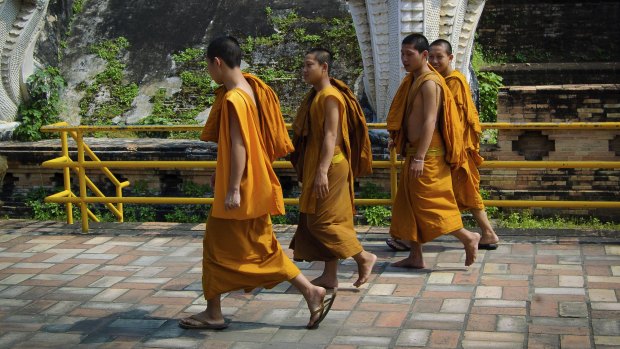
Monks walking in Chiang Mai. Credit: iStock
Temples might be sacred, but in Asia's crowded cities they often offer a pocket of green space and serenity, where locals can gather, exercise and relax, the way we do in city parks, and they can be the perfect place to chill out, have a picnic lunch, find a shady spot and read a book or people watch.
"The Temple of Heaven in Beijing, for example," says Helen Wong, the managing director of Helen Wong's Tours, "was built by the emperor to pray for a healthy harvest, but is seen as a perfect spot to see the locals meet up to play mahjong, or even perform tai chi in the mornings."
Kennaway agrees. "It never hurts to just find a quiet spot to sit and observe life around the temples rather than trying to run around and catch every little detail," she says, warning that otherwise, "you'll exhaust yourself!"
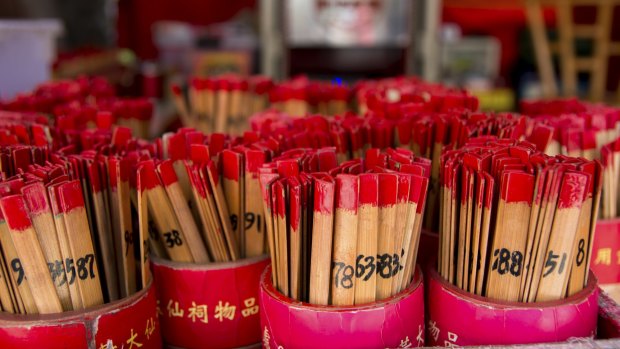
Fortune-telling sticks at a buddhist temple in Hong Kong. Credit: iStock
"A good itinerary should be well balanced, mixing stand-out tourist sites with amazing scenery, great food and always a local encounter of some sort," Raman says. "Wander around a market, enjoy street food, visit a school or take a scooter around the main sites."
Back in Chiang Mai, I decide the best way to fight temple fatigue is to not even try, and head instead to Wulai Road – otherwise known as Saturday Walking Street. By day it's the place to go if you want to buy silver, but about 4pm on Saturday the street is closed to traffic and becomes a kilometre-long market, selling handicrafts and clothes that are better quality than you'll find at the more famous Night Bazaar. It also has plenty of food stalls so you can snack while you shop. The vendors are still setting up when I get there, so I wander around for a while, ending up down a tiny laneway that's not even on my map, dazzled by an extraordinary temple completely encased in silver. I spend an hour or so watching the silversmiths at work in the temple grounds, awed by the intricate silverwork on temple walls.
The next day I hail a tuk tuk and take a ride to the western outskirts of the city to Wat Umong, just off Suthep Road. Built in 1297 and then abandoned for 600 years, the temple complex is surrounded by jungle and the temple buildings are mostly underground, tunnelled into the hillside. Ancient moss-covered stone buddhas litter the grounds, birds flit among the giant banyan trees and young monks giggle in the shade. I'm the only tourist there and I wander around the grounds reading the Buddhist proverbs hanging in the trees ("Cut yourself some slack, one hundred years from now, all new people."), stroll around the small lake and earn some karma by feeding the fish. Despite the chronic temple fatigue of the day before, months later these two low-key temple visits remain the most memorable moments of my entire trip.
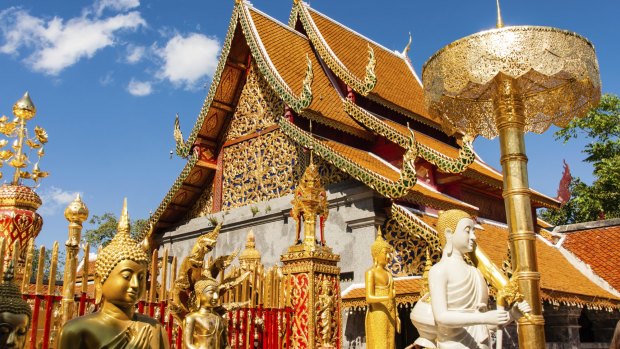
Wat Phra That Doi Suthep, Chiang Mai, Thailand. Credit: iStock
TEMPLE FATIGUE TACTICS
SLEEP ON IT
Actually, make that sleep in it. Korea has a temple stay program, where you can spend the night in an ancient Buddhist temple, eating with the monks (or nuns), joining in morning meditation sessions and tea ceremonies, and even prayer sessions. See eng.templestay.com.
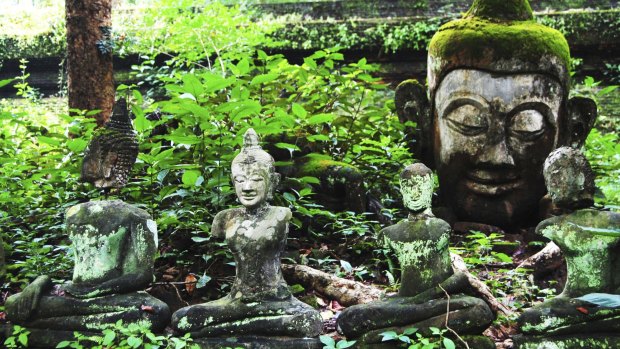
A broken head of a buddha at Wat Umong on the outskirts of Chiang Mai.Credit: iStock
GET A MASSAGE
Wat Pho – also known as the Temple of the Reclining Buddha – is one of Bangkok's oldest and largest temples and most popular sights. It's also home to a school for traditional medicine and massage – a good back rub is a sure way to fight temple fatigue.
CHAT WITH A MONK
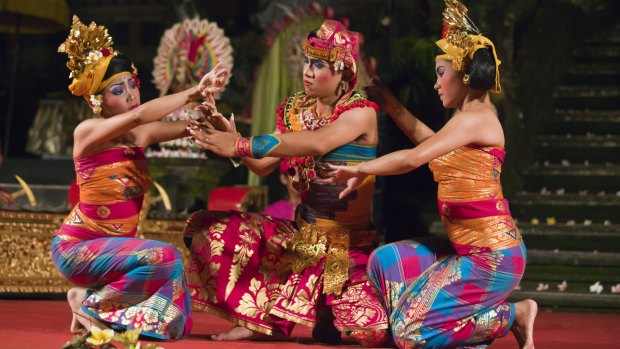
Dancers from the Cenik Wayah Gamelan Group perform at Pura Taman Saraswati, Ubud, Bali.Credit: Getty Images
Many Thai temples, particularly in Chiang Mai, offer "monk chat" sessions, where you can find out everything you've ever wanted to know about being a monk, Thai culture and customs, and the monks can practise their English. It's casual and depending on how chatty your monk is, can be a lot of fun.
GET YOUR FORTUNE TOLD
If you want to know whether your prayers will be answered, head to a Chinese temple – most have a resident soothsayer who can interpret your future, often through the use of Kau Cim – rattle a cylinder full of numbered sticks to shake out what fate has in store. Wong Tai Sin Temple in Hong Kong is renowned for the accuracy of its fortune-telling sticks.
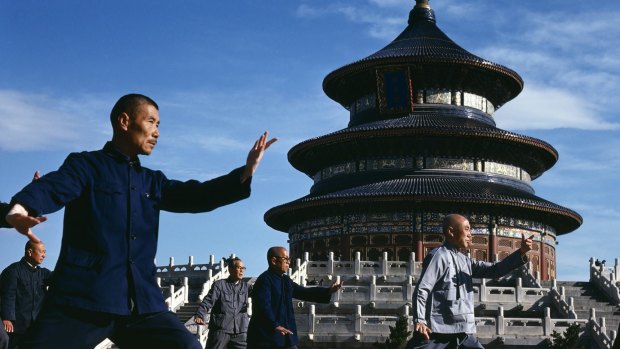
Men practise tai chi in front of the Temple of Heaven in Beijing, China.Credit: Getty Images
HAVE A CUP OF TEA
Kyoto is home to more than 2000 temples, but it's also the spiritual home of the Japanese tea ceremony. Teahouses all over the city perform elaborately formal tea ceremonies, often at elaborately formal prices, but many temples offer simple versions at a fraction of the price.
WATCH A SHOW
Many Balinese temples stage traditional dance shows, ranging from dramatic retellings of mythical Hindu epics to firewalking and Kecak – where singers enter a trance as they chant. Ubud is the best place to catch a show and there's usually one in a temple somewhere every night of the week.
FEED SOME FISH
Many Thais believe that feeding fish is a guaranteed way to earn merit points (good karma) and almost every temple, particularly if it is near a river, will have a fish feeding station where you can buy a bag of fish food and create a feeding frenzy. Don't be tempted to feed any resident monkeys though, particularly in Bali – they're cute until they pinch your sunglasses and bolt, so keep your belongings close.
MEDITATE
Tame the mind on a temple-based meditation retreat, popular in Myanmar (special meditation visas are valid for three months rather than the usual 28-day tourist visa) and Thailand – Chiang Mai's most famous temple, the Wat Doi Suthep, has a range of meditation retreats from four days to three weeks. Basic accommodation and meals are provided, and fees are by donation only, but you'll need to be prepared to wear only white, wake up at 5am, and subsist on two meals a day.
Lee Atkinson was the guest of the Tourism Authority of Thailand.
Sign up for the Traveller Deals newsletter
Get exclusive travel deals delivered straight to your inbox. Sign up now.